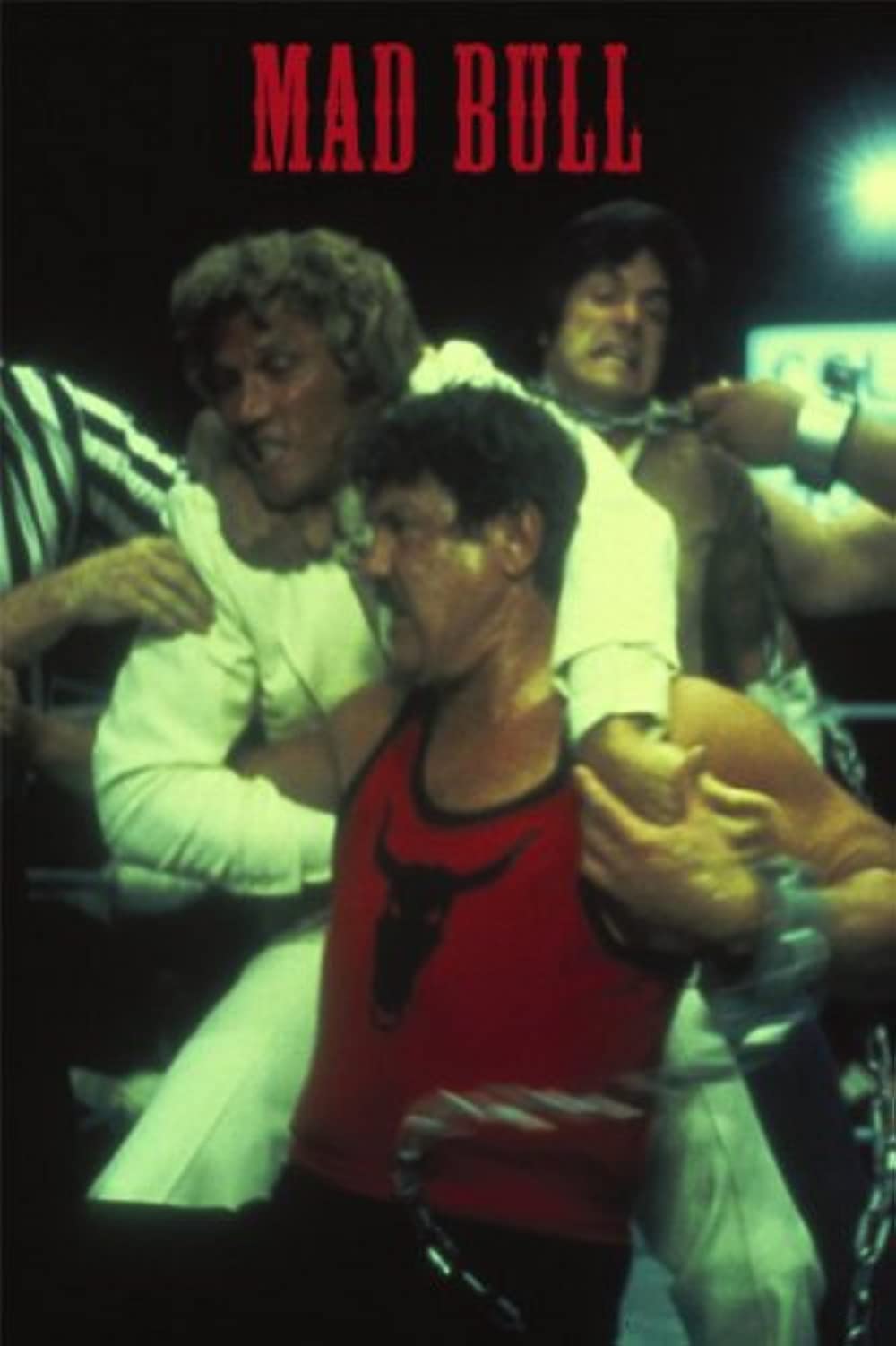The late Alex Karras was no stranger to the Wrestlecrap. It was he, after all, whose “Mongo” character in Blazing Saddles was the namesake of Horseman Steve “Mongo” McMichael.
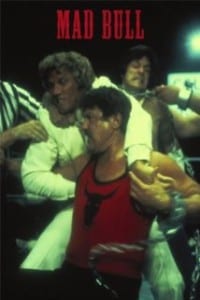
Less famous was the 1977 TV movie, “Mad Bull,” where Karras played the title role of Iago “Mad Bull” Karkus. Since this was the seventies, not everyone was in on the fact that wrestling was fixed. Sure, “not everyone” included about 90% of the public, but it didn’t include this guy:
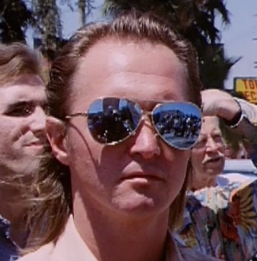
That’s Mad Bull’s stalker and would-be assassin, who repeatedly tries to murder him because he’s a heel. As the old saying goes, kayfabe kills.
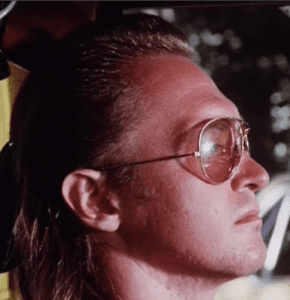
The unnamed vigilante, a cross between Heath Slater and Dale Gribble (his threats even sound like Hank Hill’s neighbor), spends most of his time sitting in the stands, staring at Mad Bull with silent rage.
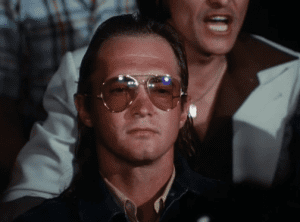
No, Andy Leavine isn’t with him; this guy is just angry.
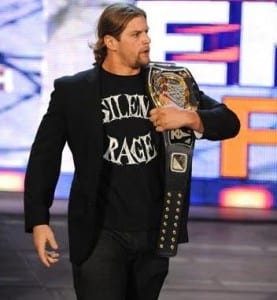
We soon learn that Heath Gribble has a lethal plan for our protagonist after the vigilante shoots Mad Bull’s picture with a dart gun…
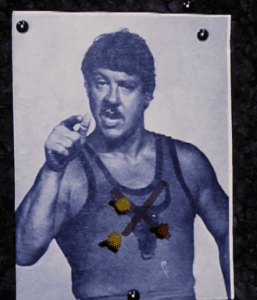
…and stuffs two pistols down his pants pointed directly at his crotch, as any sensible person would do.
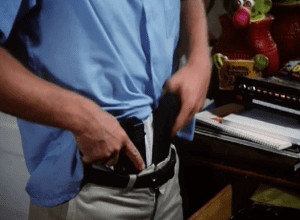
That 70’s Assassin then encounters Mad Bull on a deserted highway, where he announces over a loudspeaker that the wrestler is a criminal before ramming into his car and running him off the road.
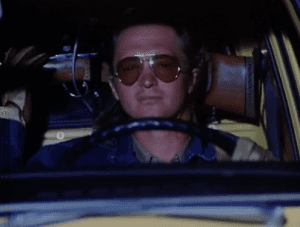
At least he didn’t film it like the nWo did, but then again, Hogan, Hall, and Nash weren’t driving a yellow pick-up truck with loudspeakers when they made the Steiners flip their car, so don’t give this guy too much credit for staying under the radar.
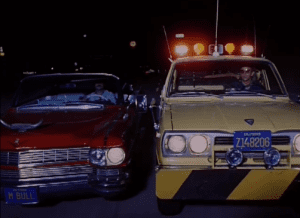
The Man With The Yellow Truck strikes again after a show, when he means to shoot Mad Bull but instead shoots Mad Bull’s brother, who happens to be wearing Bull’s signature white cowboy hat at the time.
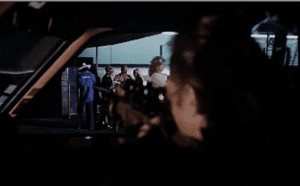
Of course, the police don’t catch the guy, since they can’t tell his yellow pickup truck with loudspeakers from all the other yellow pickup trucks with loudspeakers driving around on public streets.

Mad Bull’s other foe is a wrestler named “White Knight” (not to be confused with the Red Knight, who was Barry Horowitz).
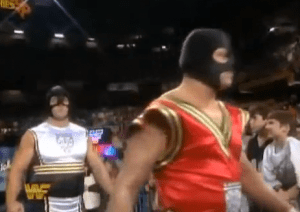
Despite being a face, the White Knight is a grade-A A-hole (Grade A-Hole?) who never really does anything to merit the fans’ adoration.
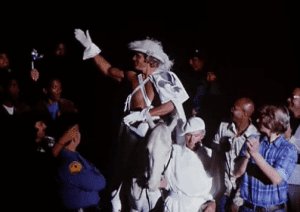
Essentially, he’s the 1970s version of babyface Miz, except people actually cheer him. Okay, so he’s more like the 1970s version of babyface Randy Orton.
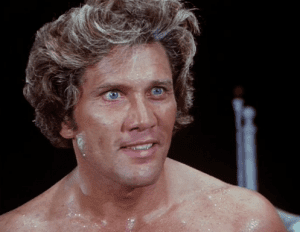
To make matters worse, he really, really likes to injure his opponents, making him unpopular backstage. But what White Knight lacks in likability, he makes up for with an unexplained midget sidekick who’s apparently not only his manager…
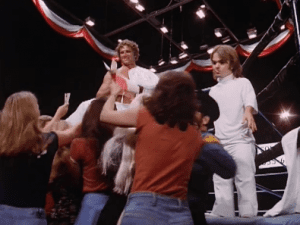
…but his masseur…
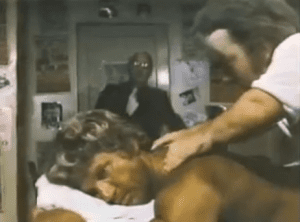
…and personal barbell.
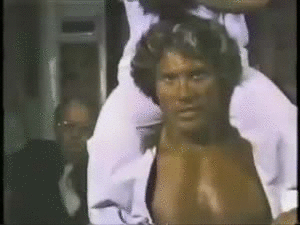
Mad Bull earns a title shot against White Knight when he and his brother, The Executioner (who comes complete with a Terry Gordy-esque plastic axe), defeat the champion in a tag team match.
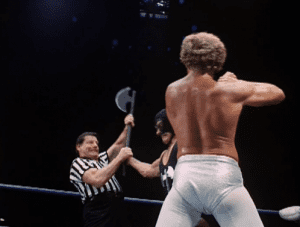
Actually, they lose, but the decision is reversed when White Knight’s partner, Mr. Clean, is deemed to have not spent enough time in the ring. Not even Dusty Rhodes had the guts (so to speak) to pull off a screwjob finish like that! Why, if the Rock & Roll Express had to compete under those rules, they’d have a win-loss record rivaling that of the Conquistadors. That’s also a really weird way to earn a title shot. If Mad Bull were wrestling in WWE, he would have just beaten White Knight three weeks in a row in non-title matches to get his shot.
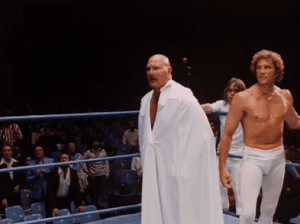
That’s not the only strange set of rules seen in the movie. On the same night as an intergender battle royal (and I mean that literally – one of the “female” wrestlers is named Sex Change), Mad Bull wrestles in what is alternately called a “Death Match” or a “Chain Match,” where the only way to win is drag your opponent around the ring by the chain and touch all four turnbuckles. The match ends after Mad Bull pins his opponent for a three-count, then gets sneak-attacked by White Knight, who is fended off by Mad Bull’s brother. The result? A double-disqualification. Still following this?
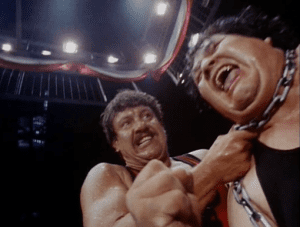
Not only did this movie’s writers invent the type of messed-up endings made famous by WCW, they also created wrestling’s most popular gimmick, that of the Undertaker. Sort of. See, in the movie, the booker gives a former “hayseed” wrestler the moniker of “The Happy Undertaker.” That’s like if Hillbilly Jim had been repackaged as The Dead Man.
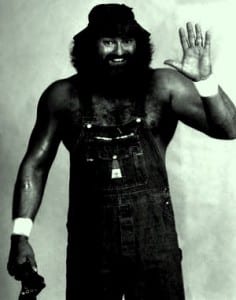
The strangeness continues. As the movie makes it clear that wrestling is fixed, you’d hardly believe it was made in the seventies (until you hear the theme music). However, this being the pre-dirt sheet days, no one, not even the wrestlers and bookers themselves, use terms like, “heel” or “babyface.” Instead, they call everyone either a “good guy” or a “bad guy.” While it’s nice not to have to endure line after line of dialogue trying to cram in “insider” terms like so many other wrestling movies (even “The Wrestler” opens with a promoter praising Randy The Ram for “putting over” the crowd), it gets kind of silly listening to supposed big-time players talk about the industry like they’re seven years old.
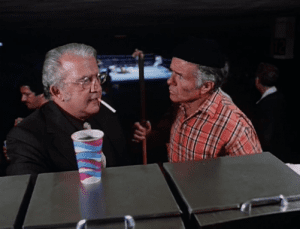
Not that that’s unheard of.
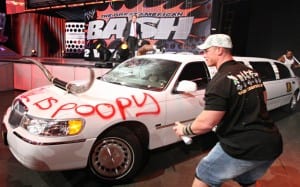
Speaking of The Wrestler, no good wrestling movie would be complete without a love interest. Mickey Rourke had Marissa Tomei; Alex Karras has some chick named Peaches.
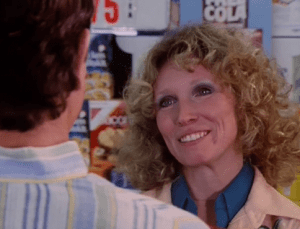
See, it’s not easy for a wrestler: being on the road, keeping secrets from one’s family, getting divorced, having to be a role model to one’s estranged son with a disability (the inability to say anything but, “C’mon dad!”).
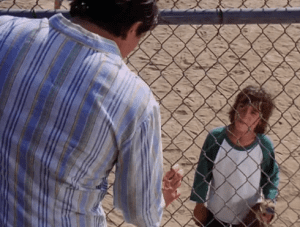
Luckily, Mad Bull meets his future Mad Cow at a supermarket run by Regis Philbin. There to do a promotional spot where he lifts hundreds of pounds of peaches, Bull hits it off with an employee named Christina, and for the rest of the movie, he calls her, “Peaches” (which was also the name of one of Eric Bischoff’s hot lesbians at Unforgiven ’02).
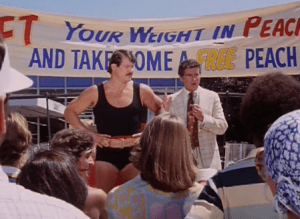
Scoff if you will, but at least he doesn’t name her after stepping in dog crap, like in another wrestling movie.
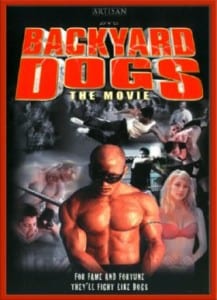
Mad Bull and Peaches’ whirlwind love affair heats up in typical fashion, namely a romantic trip to the zoo, complete with long shots of gorillas.
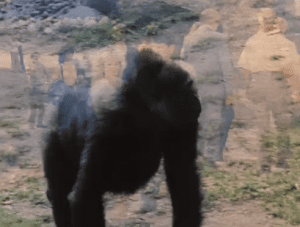
When he takes Peaches to one of his matches, though, she’s disappointed in his profession because it’s fake. Much like Iago’s super-Greek father (a former wrestler himself), she wishes he would have the courage to fight for real. You know, like Hackenschmidt or Gotch or, uh, Sting when he wrestles a pilled-up Jeff Hardy.
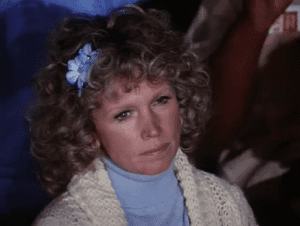
Oh, I didn’t mention Iago’s super-Greek father? Well, he is so Greek…
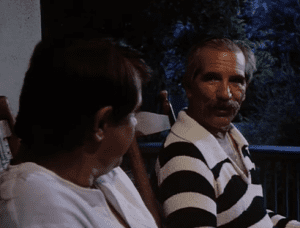
“How Greek is he, Art?”
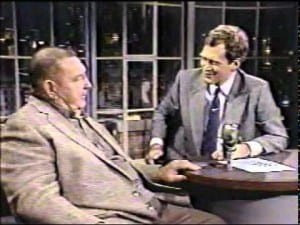
He is so Greek that he invited an Orthodox priest to his house party. Also, he named his kid “Iago.”
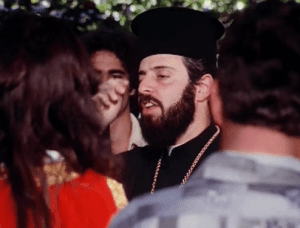
Not that there’s anything wrong with being Greek. Why, if every old-time wrestler were as proud of his Greek heritage and didn’t try to hide it, we could have been spared John Tolos’s stint as “The Coach.”
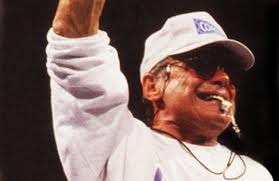
Anyway, all these plot points converge at the next big event: the vigilante mark, the title shot versus White Knight, the love interest, the estranged son, and the stigma of being a “fake.” First, Mad Bull does battle with the champion in a cage match.
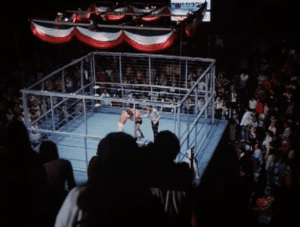
Mad Bull’s wounded and hospitalized brother encourages Peaches to go to the arena in person because Bull needs her support. At his urging, she rushes out of the hospital, takes a cab to the arena, then stands outside in the parking lot for the whole match because the show’s sold out. Mad Bull’s brother is kind of an idiot, you see.
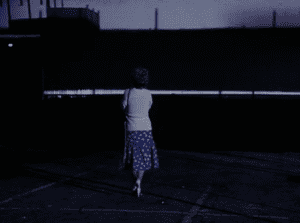
Meanwhile, Mad Bull decides to do his father proud and win the respect of Peaches by fighting for real, shooting on White Knight, who is booked to win the match and retain his title. As White Knight resorts to devious tactics to hold his own against Mad Bull, the audience turns against him and starts cheering the supposed “bad guy” (because, again, it’s the seventies and none of the fans have heard of the word, “heel”).
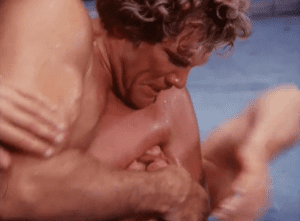
Even his son watching on TV cheers him on, despite his mother demanding he turn off the TV and work on building his vocabulary.
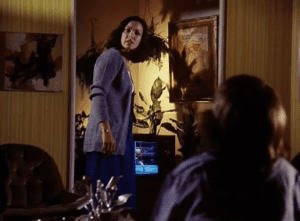
Seeing how arrogant White Knight is (prematurely shouting “I’m the winner” over and over again), the fans are 100% behind Mad Bull by the dramatic end of the match, where he and the champion straddle the top of the cage, trading blows for the approximate length of a Divas match.
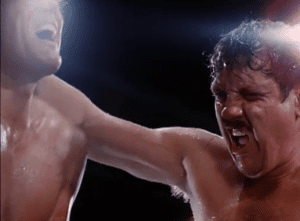
Finally, Mad Bull climbs down and earns the admiration of the fans, the respect of his peers and family, and the heavyweight championship.
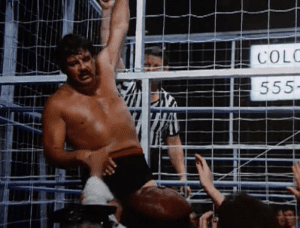
And his boss is apparently fine with him re-booking on the fly, forcing an unscheduled title change, and making everyone hate his cash-cow babyface. Don’t you think Vince would have loved it if Andre the Giant had shoot-fought Hogan at Wrestlemania III, turned the Hulkster heel, and made himself the champion?
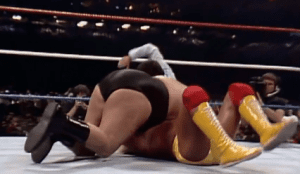
For some reason, Mad Bull’s career isn’t over, but his life might be if he isn’t careful! That’s because his stalker is at the arena waiting to kill him after the show. Somehow, the police and security guards managed to overlook the yellow pickup truck in the parking lot, letting the World’s Most Dangerous Fan slip into the building. Mad Bull doesn’t recognize the crazed man who ran him off the road, leaving himself an easy target as he takes a gunshot to the arm.
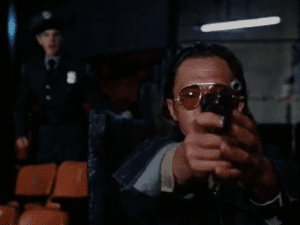
The gunman tries to flee in his oh-so-inconspicuous truck, but for the first time in the whole film, someone recognizes him. He draws the ire of the entire locker room, who lift up his truck, give it an airplane spin, and dump it upside down with him inside. And you thought using wrestling moves in the real world would look stupid!
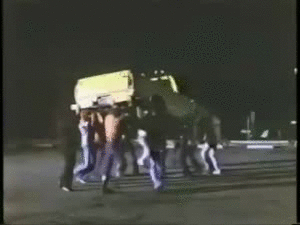
Mad Bull, in invincible face mode, no-sells his gunshot wound, suffering only a small stain on his sleeve as Peaches offers to take him out to a Greek restaurant, rather than, you know, the emergency room. Cue end credits.
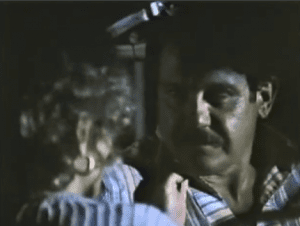
As clunky as this movie is, it speaks some important truths about wrestling:
- The police are powerless to protect anyone
- Attempted murder can be avenged by wrestling moves (even on a vehicle)
and, most importantly,
- a superfan like this may seem harmless…
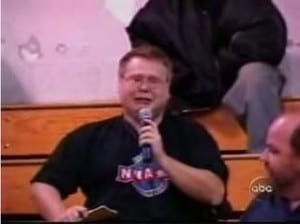
…but he is only one garish pickup truck away from turning into a ruthless killer.

